Do you have a reactive dog and are looking to board him?
As an owner of a reactive dog myself, I know how stressful the idea of boarding your sensitive and problematic pup can be. But chances are, at some point you’re going to have to find a solution for those emergency trips when you need to leave town.
And yes, you deserve to take a dog-free vacation now and then too!
For many reactive dogs, boarding at a reputable facility can work out just fine, so long as your pup is properly prepared and you’ve done your research choosing a boarding kennel that understands how to handle reactive residents.
In this guide, we’ll take you through how to find an appropriate boarding kennel for a reactive dog, how to prepare your dog for boarding to ensure a smooth transition, and explore alternatives for those dogs who just can’t handle the boarding environment.
A lot of these selection criteria and boarding considerations apply to non-reactive dogs as well, so even if your pup is a perfect angel, consider employing the tips provided below before boarding your fur kiddo!
First, Consider What Kind of Reactivity Your Dog Struggles With
Reactivity is a bit of an umbrella term, as it can refer to any manner of intense or over-the-top reactions to various triggers. Perhaps your dog gets along fine with other dogs, but is fearful of strange men. Maybe your dog adores two-legged folks, yet lunges and snaps at his furry peers. Or, you may have a leash reactive dog who turns into a tornado at the end of the leash, but gets along fine with other pups and humans alike when off leash.
No matter the case, you’ll need to be able to clearly articulate exactly what sets your dog off and what type of reactivity you’re dealing with in order to find him a safe, appropriate kennel.
Not only will this help you evaluate boarding facilities, but it’ll also allow the boarding kennel staff to understand your dog’s needs and decide if they are a good fit for your four-footer.
Here, we’ll largely focus on finding kennels that cater to dogs who are reactive toward other dogs, as this tends to be the most common type of reactivity.
You never want to mislead or withhold information about your dog’s reactivity to a potential boarding facility. While it can be frustrating trying to find a boarding kennel that can handle your dog, not being honest or clear about your dog’s issues is extremely dangerous for your dog, boarding staff, as well as other dogs being boarded. Besides, you may be surprised how many kennels are willing to handle more challenging dogs, so long as you’ve given clear instructions.
We’ve also made a video covering the same topic, so if you’re more into watching videos than reading, check out our YouTube vid:
What to Look For When Boarding a Reactive Dog: Choosing the Kennel
Let’s dive into some of the criteria to use when evaluating and choosing a dog boarding kennel for your reactive four-legger. You’ll always want to listen to your gut, but some of the key things to look for when trying to board a reactive dog include:
Premium Kennel Options
When it comes to boarding a reactive dog, you’ll really only want to consider facilities that offer above-average kennels. These are often referred to as luxury or premium kennels, and they tend to be more isolated than open-air kennels.
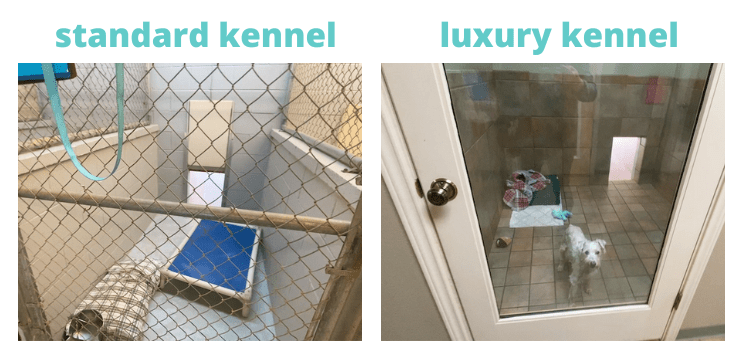
While standard kennels may have cement bottom portions with chain-link top sections, luxury kennels are usually completely contained, with a solid barrier around the entire kennel portion. This results in less auditory and visual stimulation, as the dog won’t be able to hear or see other dogs (or, at the very least, will not see or hear the other dogs as much).
Some luxury kennels also feature additional sound-proofing materials and quiet classical music piped in to help relax nervous pups.
If luxury kennels aren’t available, you may be able to get by with staff hanging a towel or sheet across the front or sides of the kennel, adding visual barriers that will prevent your pup from having a sightline to other dogs.
Indoor & Outdoor Access
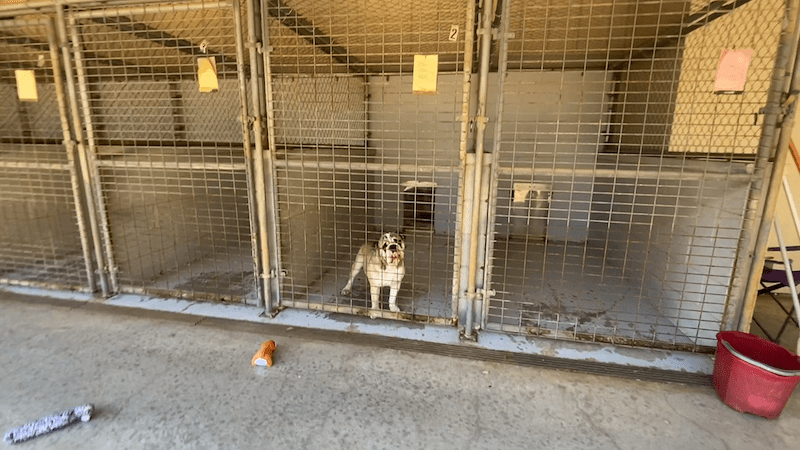
Not all kennels will have indoor and outdoor access, but it certainly can be a great bonus. Having access to the great outdoors is obviously pleasant for most canines, but it can be especially helpful for reactive pups.
For example, if your dog is challenging for strangers to handle, built-in outdoor access may also allow your dog to relieve himself without a caregiver escorting him outside. This can depend a bit on the type of outdoor area your dog has access to – some dogs may be willing to go to the bathroom on pieces of sod or astroturf, but if the outdoor area is concrete, a housetrained dog will likely hold it in.
Solo Play Time and/or Walks
Most boarding kennels will allow the boarded dogs to join playgroups each day – similar to what you might find at a doggie daycare facility.
For most reactive dogs, this isn’t a viable option. So, you’ll want to investigate what kinds of alternative services the boarding facility offers for dogs who don’t get along with others.
Some boarding kennels might allow your reactive dog to enjoy some solo time in a gated area or outdoor dog run each day.
This is the very kind of service that let me zero in on a kennel when I was seeking a boarding facility for my reactive dog Remy.
The boarding facility grounds were large and lush with tons of trees and grass. This meant that even when Remy was just left to his own devices in an outdoor fenced area, he had plenty of space to sniff and explore, which I knew he would enjoy.

Some boarding facilities might also offer one-on-one playtime with a staff member, or the option for solo hikes or walks with a staff walker.
Just make sure you ask what the options are for reactive dogs. Leaving your dog shut in a kennel, isolated for his entire stay isn’t a solution! Your dog will absolutely need some kind of physical activity or engagement while he’s being boarded.
This is true for all dogs, but especially for reactive dogs who will likely be especially stressed and anxious during boarding. Having a chance to get outdoors and explore a bit can do wonders for lowering a pup’s stress levels!
Some of these one-on-one services like solo dog walks will probably cost you extra. It does stink, but boarding staff often have their hands full just feeding and caring for the dogs that are being kenneled there. Solo dog walks take up significant resources for a boarding kennel, so expect to pay extra to get your dog hands-on attention.
In-Kennel Enrichment Opportunities
Physical exercise isn’t the only thing your dog needs to have a good stay at their boarding kennel – he needs mental enrichment too!
Lickimats and frozen KONGs are perfect for stimulating your dog’s brain while also helping him stay calm. Licking can reduce your dog’s stress level, so find out if the boarding kennel can provide your pup with some licking activities or chews to entertain him.
Most boarding programs will offer these types of hospitality upgrades for additional fees, but you may be able to find one that’ll let you circumvent these fees by providing your own treats – you’ll just have to look around and inquire.
I was lucky enough to find a boarding kennel that was on board with giving Remy a Lickimat or frozen Kong each day from the stash I packed for him.
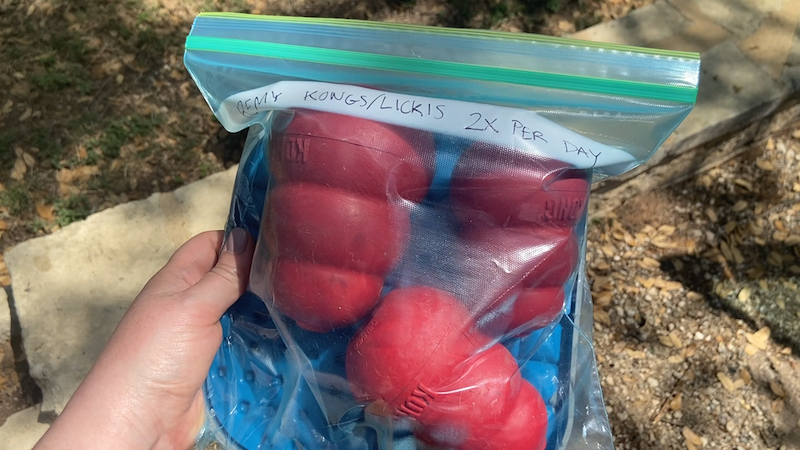
Experienced Staff Who Can Handle Reactive Dogs
Naturally, you’ll want to make sure the boarding kennel staff members are familiar with reactivity and have experience handling reactive and challenging dogs in general.
So, be sure to specifically ask if staff members have experience with reactive dogs. Also take note of what the questions they ask you. Competent and experienced canine caretakers will ask very deliberate, pointed questions about your dog’s triggers and demeanor so that they can give him the best care possible.
Finally, you’ll want to consider checking the qualifications and certifications of the staff members highlighted on the boarding facility’s website.
Good Google and Yelp Reviews
When choosing between various boarding kennels, browsing through user reviews is never a bad idea. Specifically, you’ll want to look for other owners who have reactive dogs themselves and find out about their experiences.
We all know how some folks can be when leaving reviews, and accidents occasionally happen with any business. So, don’t allow one negative review to dissuade you.
But, pay close attention to any gross negligence or oversight. For example, if you see a reviewer talking about how their dog-aggressive pup was put into a playground despite the owner’s warnings, run the other way!
There will always be a few critical reviews, but as long as the boarding facility meets most of the criteria outlined above, and as long as the reviews are mostly positive, your pup will probably be A-OK!
It’s also never a bad idea to ask your veterinarian or dog trainer if they have any recommendations.
Veterinarians are not behaviorists, so they won’t always necessarily know which kennel options will work best for reactive dogs, but they may be able to at least point you in the direction of a few reputable boarding facilities they are familiar with.
Questions to Ask The Boarding Facility
Once you’ve narrowed down your boarding selection, don’t be afraid to ask a few questions of the staff.
If staff struggles or hesitates to answer any of these questions below, consider why and proceed with caution!
- What’s the daily schedule for a dog at your boarding kennel?
- How often will my dog be taken out of his kennel?
- Where will my dog spend his time when he’s outside of his kennel?
- How often will my dog be walked? If walks aren’t provided, can I pay more for more for them?
- How often will my dog be fed?
- What supplies should I bring for my dog?
- What happens if my dog has an accident in his kennel?
- What is the procedure in the event of an emergency?
- Are dogs given any kind of in-kennel enrichment?
For Reactive Dogs Who Can Handle Playgroups
Most reactive dogs probably won’t be in playgroups, but for those that will, make sure to also ask:
- What happens if my dog doesn’t get along with other dogs?
- What happens if my dog gets attacked by another dog?
- Are the dogs separated into smaller groups or do they all play together?
If your dog will be participating in a playgroup while at the boarding kennel, I’d also suggest reading our full guide on how to choose a doggie daycare, as there we talk more in-depth about what to consider for facilities that offer a daycare component.
What to Bring For Your Dog When Boarding
When it comes to packing for your dog’s boarding stay, make sure your pup has everything he needs to have a good time. This includes:
- Toys and Chews: Provide your dog with some of his favorite toys and chews — as long as you know he can be safely left with them unattended, as staff won’t have their eyes on your pup all day long.
- Bed: A cozy and familiar place to sleep can do wonders for helping a reactive dog feel a bit more at home.
- Feeder Toys: If you usually feed your dog through a puzzle toy, it’s a good idea to keep up with that routine at the boarding kennel too, so long as the boarding staff is on board.
- Dog Food: Some boarding kennels will offer to feed your dog from their own stash of food, but this is usually something you want to avoid. Switching diets from one dog food to another can be tough on a dog’s stomach and is a common cause of gastrointestinal distress and diarrhea. Keep your dog on his regular dog food to avoid an upset stomach!
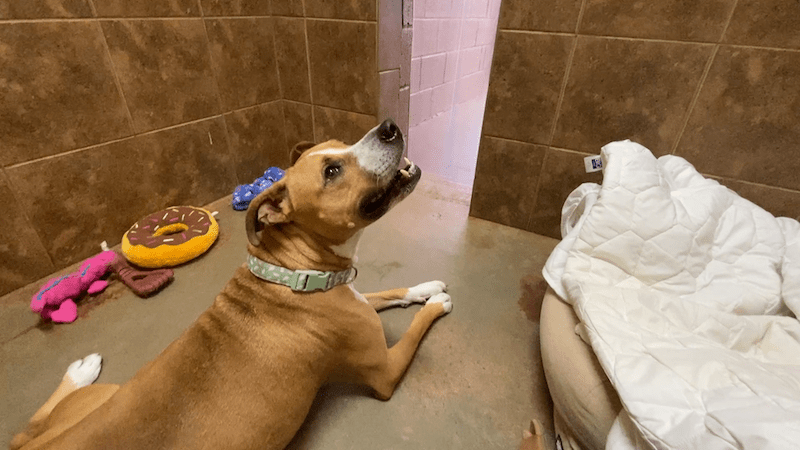
Other Considerations for Reactive Dog Boarding
In addition to gear and selection criteria, there are a few other things you may want to consider when boarding your reactive canine.
- Talk to your vet about behavioral medications. If you’re concerned about how your dog will react to the stress of boarding, you may want to talk to your vet about dog behavioral medications, such as the canine form of Xanax. Just make sure you leave plenty of time to test the medication at home before boarding – you don’t want your dog’s first experience with any drug to be in a strange new location, especially when you don’t know how his body will react to the meds.
- Consider having your dog groomed during his stay. Some boarding kennels offer bonus grooming options, such as haircuts, baths, nail clippings, and even anal gland relief. Consider if you want to tack on one of these services to your dog’s boarding stay.
- Ask if they offer video camera services. This isn’t a very common feature, but I have seen some boarding kennels offer the option to set up a camera to livestream your dog’s kennel, allowing you to keep tabs on your dog virtually. This can be a nice bonus feature for nervous pet parents who want eyes on their pup!
For any reactive or sensitive pooch, it’s always a good idea to visit the boarding facility beforehand. Just a quick walk around the grounds can allow your dog to sniff and smell the area, making it instantly more familiar when they arrive for their boarding stay. Ideally, the more pre-boarding mini visits, the better!
What to Avoid in a Boarding Kennel
We’ve covered what to look for when choosing boarding for a reactive dog. But what should you avoid when picking one?
Generally speaking, you’ll want to steer clear of:
- Board and Train Facilities: In our full guide we talk about the pros and cons of board and train facilities, but they’re typically not ideal for reactive dogs. While there are certainly some good options out there, the vast majority are overpriced and even downright dangerous. In recent years, there have been increasingly more tragic deaths reported at board-and-train facilities. The danger is even more extreme for reactive dogs, as inexperienced trainers may resort to forceful and more aggressive strategies in an attempt to curtail a dog’s reactive behaviors, with no oversight from the owner. While the idea of sending your pup to a place where they can be safely housed and trained while you’re on vacation is appealing, it’s probably not worth the risk.
- Places That Refuse to Give You a Tour: Always ask to tour a boarding kennel before signing your dog up to stay. If the staff refuse to give you a tour, that’s a huge red flag!
- Kennels That Use Aversive Tools. At K9 of Mine we strongly discourage the use of aversive tools to train and manage dogs. But we especially don’t like the idea of these dangerous tools being used on a dog without oversight from the owner. If a boarding kennel uses e-collars or prong collars on their resident dogs, we’d suggest considering other options.
- Facilities Without Experienced Trainers or Behaviorists on Staff: Every good boarding kennel should have at least a few trainers or behaviorists on staff. That doesn’t mean that everyone at the kennel needs to be a IAABC-certified dog behaviorist, but there should at least be a few folks around who are more qualified to handle challenging dogs.
- Facilities That Leave Dogs Unattended in Playgroups or Group too Many Dogs together at the Same Time: Groups of dogs should never be left unattended. If you ever see a group of dogs without a staff member keeping a close eye on them (or, if you see an improper dog-to-human ratio in playgroups), think twice before boarding your dog at that kennel.
Boarding Alternatives for Reactive Dogs: Kennels Aren’t for Everyone
The truth is, kennel boarding won’t work for all dogs. Despite doing everything I could to prepare my own reactive dog Remy for a short boarding stay, he had a pretty miserable time. I could tell just by hysterical and stressed he seemed when I picked him up.
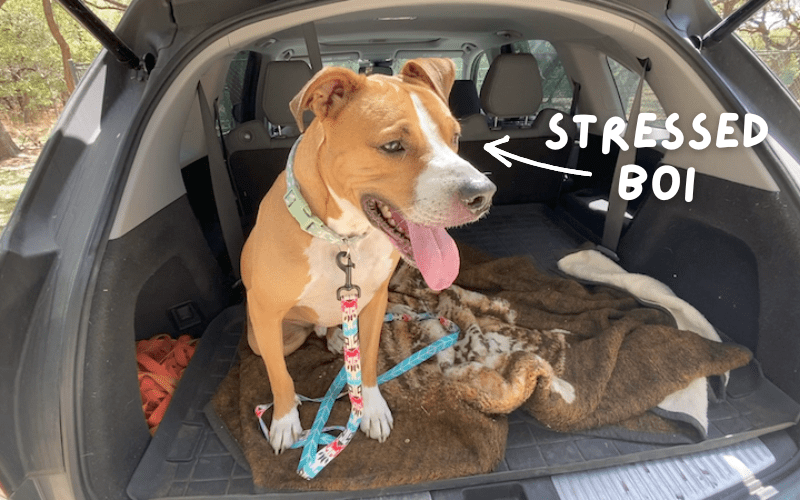
In the future, I’ll consider some reactive dog boarding alternatives, such as:
Hiring an In-Home Dog Sitter
The option your dog will likely enjoy the most is having a in-home sitter come and stay at your house.
Many dogs – especially our special reactive buddies — are really comforted by structure, routine, and familiarity. And this means that staying in their home will be the most low-stress option.
The biggest hurdle for this option tends to be finding someone who you trust to stay in your home and can adequately handle your dog’s particular needs and challenges.
When bringing in an at-home sitter, your best bet will be to find someone who is already familiar and comfortable with your dog. A friend or family member who already knows how to handle your reactive dog may be the easiest option.
Alternatively, you can seek out a qualified dog sitter who has existing experience with reactive dogs. For any new dog sitter, you’ll want to slowly introduce your dog to the future-sitter in small sessions. If you choose to bring in a stranger, we’d suggest doing several walking sessions and mini at-home visits prior to the trip.
Rover can be a great way to find qualified dog sitters, but be honest about your dog’s reactivity and behavior issues, as not all Rover sitters know how to handle challenging dogs. Rover will show how many sessions each sitter has completed, and we’d recommend opting for someone who has a large number of sitting sessions already under their belt.
Another great option is working with a certified dog behavior consultant who may be able to also watch your dog when you’re away. This will allow you to get a bit of extra reactivity dog training help while also allowing your dog to slowly be familiarized to this person who may be staying at your home down the line.
Enlist Someone to Perform Drop-In Visits
If your dog doesn’t have separation anxiety and is pretty independent, you may be able to get by with having someone come to your home for drop-in visits.
That way you can just have someone stop by to walk your dog, feed him, and let him out a few times a day to go to the bathroom. This won’t be enough attention for some dogs, but it may work for more aloof dogs when you’re taking short-term trips away from home.
You can even set up a pet camera to keep tabs on your pup (and the visitor) and ensure he’s doing OK.
Bring Your Dog with You
OK, this probably isn’t the best option for most folks, but if your dog is pretty well-behaved outside of the occasional outburst directed towards fellow floofs, bringing your pup along may not be the most outrageous option.
There are several hotel chains that allow dogs (some for free, some with a hefty charge), and BringFido makes it easier than ever to find nearby dog-friendly lodging. However, this is less likely to work for international trips or any journey with your dog that requires flying (especially if you have a big dog).
These options may lack the convenience or reliability of boarding kennels, but you may find that they work much better for your reactive dog, depending on his needs and disposition.
Boarding a reactive dog can certainly be tricky, but doing your research to find the right facility and providing your pup with all the essentials can go a long way to ensuring your dog has as much fun away from home as you do!
Have you ever boarded your dog (reactive or non-reactive)? How did it go? Let us know in the comments!
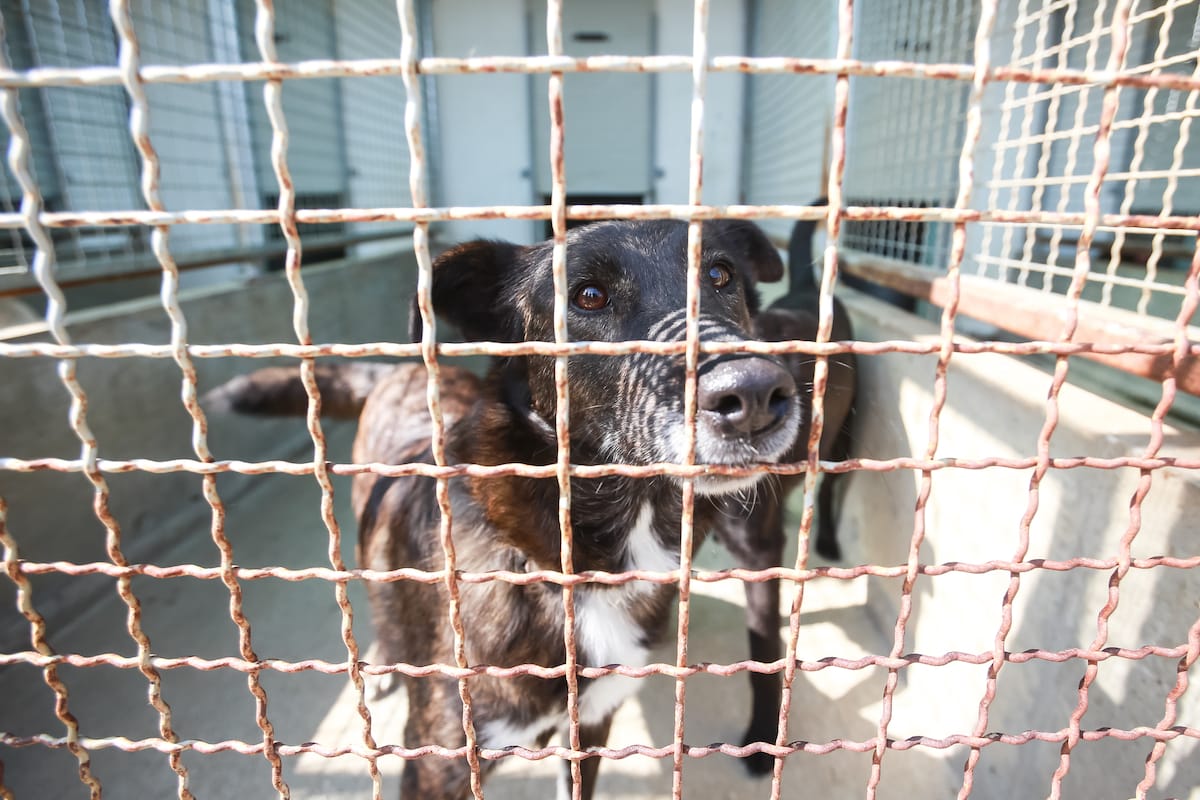




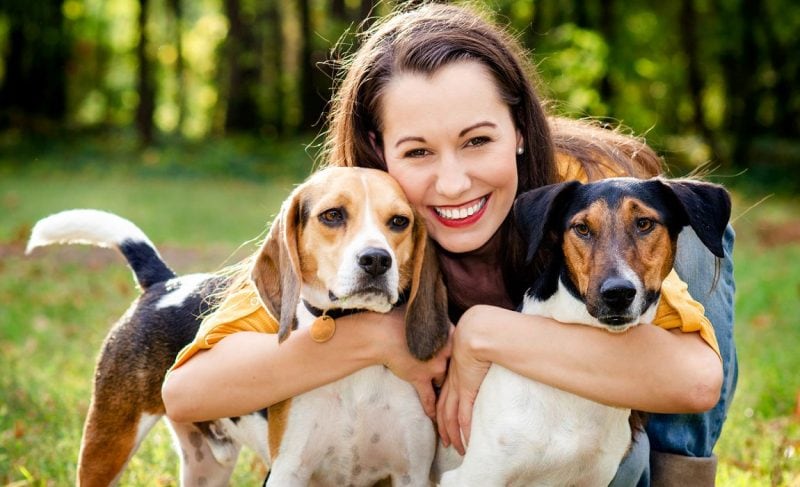


Leave a Comment